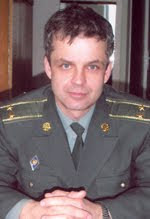Wednesday, September 4, 2013
The monument to Polish general in Leipsig
Posted by Oleg Bezverkhnii at 19:39 0 comments
Monday, July 15, 2013
Russian air force puts X-38 air-to-surface missile into service
http://english.ruvr.ru/2013_01_18/Russian-air-force-puts-X-38-air-to-surface-missile-into-service/
Posted by Oleg Bezverkhnii at 10:19 0 comments
Thursday, July 11, 2013
Exercise Rapid Trident 2013 opens in Ukraine
U.S. units participating in the exercise include an airborne-infantry company from the 173rd Airborne Brigade, Observer Coach Trainers from the Joint Multinational Readiness Center, 21st Theater Support Command, U.S. Army Europe and the California Army National Guard.
Posted by Oleg Bezverkhnii at 10:30 1 comments
Monday, July 8, 2013
One of the world's biggest open iron ore deposits is located close to Poltava
Komsomolsk is a purpose-built mining city in central Ukraine, located on the left bank of the Dnieper river, 120 km. away from Poltava. The city is pretty young, it was founded in 1960 as the residential and civic area for the Poltava Mining and Extraction Combinat. Nowadays it is controlled by the Ferrexpo - the most important iron ore-mining company in Ukraine.
80% of the city residents are employed by the mining industry. There are two gigantic open pit mines (up to 350 meters depth) and several spoil tips on the city territory, to the north-east and south of the residential area.
The industry is served by several railway stations. However, the passenger service was discontinued and the city relies on intercity and suburban bus links. The combinat operates its own freight river port. Due to the profitability of mining, small city of Komsomolsk usually ranks high in all-Ukraine city rankings of birth rate, living standards, (un)employment and housing.
Posted by Oleg Bezverkhnii at 22:40 0 comments
Sunday, June 23, 2013
On June 22, 1941 Nazi Germany attacked the Soviet Union marking the beginning of the Great Patriotic War
Posted by Oleg Bezverkhnii at 08:47 0 comments
Tuesday, June 11, 2013
Contract army: is it possible to cancel compulsory military service by 2014?
www.for-ua.com 5 June 2013
Total strength of Ukrainian army will be reduced from 184
thousand to 122 thousand soldiers, press office of the Defense Ministry reports.
Last week the Cabinet approved the army reform state program for 2013-2017,
which provides for the optimization of the army to ensure its combat capability,
which will be achieved primarily by reducing the number of personnel, without
affecting the fighting capacity.
Moreover, the program also foresees
improvement of social protection for militaries and their families, as well
upgrading of equipment and armament. The press office also reminds that the last
conscription will held this autumn, and the last conscript will leave the
service in 2014.

As ForUm wrote in the article "Volunteer army:
inevitable or incredible?", the authorities have been talking about
contract-based army for a long time. Despite permanent lack of finances, the
Armed Forces already have an experience of forming divisions and corps by this
principle. Thus, in 2000 the Armed Forces numbered 28.8 thousand contract
militaries, and in 2004 - 40.7 thousand soldiers. As of February 1, 2013 the
Armed Forces of Ukraine consist of 33% of conscripts and 54% of contract
militaries.
Posted by Oleg Bezverkhnii at 13:06 0 comments
Saturday, May 18, 2013
A holiday of military history in Djuramossa

Most of all, I was impressed with military show. Some pictures taken in the hospitable Djuramossa you can see below. Many participants and spectators were able to by a lot of books and DVDs on military history in SMB book tent. Those who got hungry, got a chance to test a real military pea soup. Even a heavy hailstorm failed to spoil such a nice holiday!

Posted by Oleg Bezverkhnii at 16:31 0 comments






